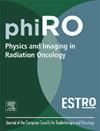用于可变形图像配准的高斯基元
IF 3.3
Q2 ONCOLOGY
引用次数: 0
摘要
背景与目的:形变图像配准(DIR)通过补偿解剖形变在放射治疗中起着至关重要的作用。然而,现有的迭代和数据驱动方法往往受到计算效率低下或泛化有限的阻碍。因此,我们的目标是开发一种新的基于优化的DIR方法,以减少计算开销,并在增强可解释性的同时保持迭代方法的鲁棒泛化。材料和方法:我们提出了一种新的DIR框架GaussianDIR,它使用自适应高斯基元的稀疏集显式表示变形场。每个原语都有其中心、协方差和相关的局部刚性变形。体素方向的位移是通过混合邻近基元的局部刚性变形来导出的,从而实现灵活而有效的运动建模。结果:在DIRLab肺数据集上,GaussianDIR在约2.5 s内实现了1.00±1.11 mm的目标配准误差(TRE),为高分辨率图像提供了速度和精度之间的有效权衡。在OASIS大脑和ACDC心脏数据集上,Dice相似系数(DSC)分别从80.6%提高到81.3%和81.0%提高到81.2%。此外,我们在IXI数据集上比较了GaussianDIR和数据驱动方法的泛化性能,发现在DSC中,GaussianDIR比数据驱动方法的泛化性能高出6.3%。结论:GaussianDIR集高配准精度、计算效率、可解释性和强泛化性能于一身。它挑战了迭代方法固有缓慢的传统观念,克服了数据驱动方法的泛化限制,具有实时临床放疗应用的潜力。本文章由计算机程序翻译,如有差异,请以英文原文为准。
Gaussian primitives for deformable image registration
Background and Purpose:
Deformable image registration (DIR) plays a critical role in radiotherapy by compensating for anatomical deformations. However, existing iterative and data-driven methods are often hindered by computational inefficiency or limited generalization. In response, our objective was to develop a novel optimization-based DIR method that reduces computational overhead and preserves the robust generalization of iterative methods while enhancing interpretability.
Materials and Methods:
We proposed GaussianDIR, a novel DIR framework that explicitly represents the deformation field using a sparse set of adaptive Gaussian primitives. Each primitive is characterized by its centre, covariance, and associated local rigid deformation. Voxel-wise displacements are derived via blending the local rigid deformations of neighbouring primitives, enabling flexible yet efficient motion modelling.
Results:
On DIRLab lung dataset, GaussianDIR achieved a target registration error (TRE) of millimeters in about 2.5 s, offering an effective trade-off between speed and precision for high-resolution images. On OASIS brain and ACDC cardiac datasets, the Dice similarity coefficient (DSC) improved from 80.6% to 81.3% and from 81.0% to 81.2% over previous state-of-the-art methods, respectively. Moreover, we compared the generalization performance of GaussianDIR and a data-driven method on IXI dataset, and found that GaussianDIR outperformed the data-driven method by 6.3% in DSC.
Conclusion:
GaussianDIR combines high registration accuracy with computational efficiency, interpretability, and strong generalization performance. It challenged the conventional notion that iterative methods were inherently slow and overcomed the generalization limitations of data-driven methods, with potential for real-time clinical applications in radiotherapy.
求助全文
通过发布文献求助,成功后即可免费获取论文全文。
去求助
来源期刊

Physics and Imaging in Radiation Oncology
Physics and Astronomy-Radiation
CiteScore
5.30
自引率
18.90%
发文量
93
审稿时长
6 weeks
 求助内容:
求助内容: 应助结果提醒方式:
应助结果提醒方式:


